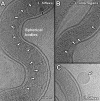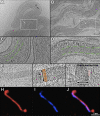Three-dimensional structures of pathogenic and saprophytic Leptospira species revealed by cryo-electron tomography
- PMID: 22228733
- PMCID: PMC3294836
- DOI: 10.1128/JB.06474-11
Three-dimensional structures of pathogenic and saprophytic Leptospira species revealed by cryo-electron tomography
Abstract
Leptospira interrogans is the primary causative agent of the most widespread zoonotic disease, leptospirosis. An in-depth structural characterization of L. interrogans is needed to understand its biology and pathogenesis. In this study, cryo-electron tomography (cryo-ET) was used to compare pathogenic and saprophytic species and examine the unique morphological features of this group of bacteria. Specifically, our study revealed a structural difference between the cell envelopes of L. interrogans and Leptospira biflexa involving variations in the lipopolysaccharide (LPS) layer. Through cryo-ET and subvolume averaging, we determined the first three-dimensional (3-D) structure of the flagellar motor of leptospira, with novel features in the flagellar C ring, export apparatus, and stator. Together with direct visualization of chemoreceptor arrays, DNA packing, periplasmic filaments, spherical cytoplasmic bodies, and a unique "cap" at the cell end, this report provides structural insights into these fascinating Leptospira species.
Figures







Similar articles
-
Cellular architecture of Treponema pallidum: novel flagellum, periplasmic cone, and cell envelope as revealed by cryo electron tomography.J Mol Biol. 2010 Nov 5;403(4):546-61. doi: 10.1016/j.jmb.2010.09.020. Epub 2010 Sep 17. J Mol Biol. 2010. PMID: 20850455 Free PMC article.
-
In Situ Structure of the Vibrio Polar Flagellum Reveals a Distinct Outer Membrane Complex and Its Specific Interaction with the Stator.J Bacteriol. 2020 Jan 29;202(4):e00592-19. doi: 10.1128/JB.00592-19. Print 2020 Jan 29. J Bacteriol. 2020. PMID: 31767780 Free PMC article.
-
Intact flagellar motor of Borrelia burgdorferi revealed by cryo-electron tomography: evidence for stator ring curvature and rotor/C-ring assembly flexion.J Bacteriol. 2009 Aug;191(16):5026-36. doi: 10.1128/JB.00340-09. Epub 2009 May 8. J Bacteriol. 2009. PMID: 19429612 Free PMC article.
-
Virulence of the zoonotic agent of leptospirosis: still terra incognita?Nat Rev Microbiol. 2017 May;15(5):297-307. doi: 10.1038/nrmicro.2017.5. Epub 2017 Mar 6. Nat Rev Microbiol. 2017. PMID: 28260786 Review.
-
Frontiers in Cryo Electron Microscopy of Complex Macromolecular Assemblies.Annu Rev Biomed Eng. 2019 Jun 4;21:395-415. doi: 10.1146/annurev-bioeng-060418-052453. Epub 2019 Mar 20. Annu Rev Biomed Eng. 2019. PMID: 30892930 Review.
Cited by
-
Histones with an unconventional DNA-binding mode in vitro are major chromatin constituents in the bacterium Bdellovibrio bacteriovorus.Nat Microbiol. 2023 Nov;8(11):2006-2019. doi: 10.1038/s41564-023-01492-x. Epub 2023 Oct 9. Nat Microbiol. 2023. PMID: 37814071 Free PMC article.
-
The leptospiral outer membrane.Curr Top Microbiol Immunol. 2015;387:187-221. doi: 10.1007/978-3-662-45059-8_8. Curr Top Microbiol Immunol. 2015. PMID: 25388136 Free PMC article. Review.
-
Mutations in the Borrelia burgdorferi Flagellar Type III Secretion System Genes fliH and fliI Profoundly Affect Spirochete Flagellar Assembly, Morphology, Motility, Structure, and Cell Division.mBio. 2015 May 12;6(3):e00579-15. doi: 10.1128/mBio.00579-15. mBio. 2015. PMID: 25968649 Free PMC article.
-
Implications of back-and-forth motion and powerful propulsion for spirochetal invasion.Sci Rep. 2020 Aug 18;10(1):13937. doi: 10.1038/s41598-020-70897-z. Sci Rep. 2020. PMID: 32811890 Free PMC article.
-
Spirochetes flagellar collar protein FlbB has astounding effects in orientation of periplasmic flagella, bacterial shape, motility, and assembly of motors in Borrelia burgdorferi.Mol Microbiol. 2016 Oct;102(2):336-348. doi: 10.1111/mmi.13463. Epub 2016 Aug 9. Mol Microbiol. 2016. PMID: 27416872 Free PMC article.
References
Publication types
MeSH terms
Substances
Grants and funding
LinkOut - more resources
Full Text Sources
Other Literature Sources
Molecular Biology Databases
Miscellaneous

